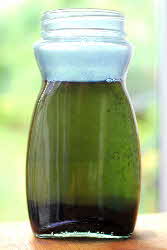|
9. Concentrating the Pigment
 Let the liquid in the jar settle for a couple of hours. You may see a blue sludge at the bottom of the jar. Carefully empty 2/3 of the jar or siphon most of liquid away with a glass siphon. Then fill it again with clean water. Repeat two or three times more until there is clear water over blue sediment. This is very exciting! Let the liquid in the jar settle for a couple of hours. You may see a blue sludge at the bottom of the jar. Carefully empty 2/3 of the jar or siphon most of liquid away with a glass siphon. Then fill it again with clean water. Repeat two or three times more until there is clear water over blue sediment. This is very exciting!
[I have tried filtering woad using an old gold-plated coffee filter, but the woad went straight through. I have also tried a car pollen filter, supposed to be 100 micron, but the pigment went straight through that as well. The woad pigment does not go through proper filter paper used in chemistry. I put a square of filter paper folded inside a funnel, and the liquid dripped very slowly. It took me 24 hours to pass all the liquid through the funnel].
We are currently using a piece of Habotai silk to filter the woad pigment. First wet the silk, then place it on the funnel, with plenty of silk overhanging the borders of the funnel. Slowly pour the liquid into the funnel. A very small amount of pigment may go through, but most of the pigment stays on the silk. You let the pigment dry on the silk and gently scrape it away with a blunt knife.
In the past we used Whatman Grade 1 filter paper, which has an 11 micron retention size, but a slightly larger micron size might also work well.
Fill the jar to overflowing one last time, and put lid on tightly. The woad should last for a year or more. It is better to use a glass jar to decant and store the woad pigment. In the past, I have used plastic soda water bottles and the woad pigment stuck permanently to the walls of the bottle.
Back to Top
|